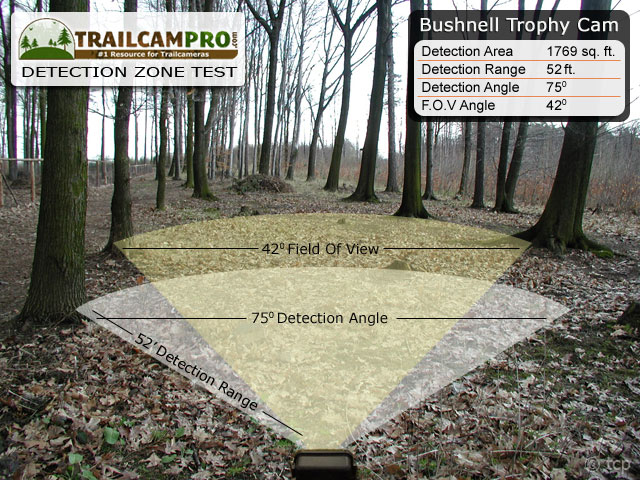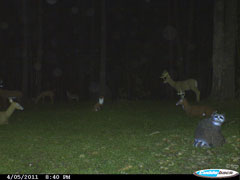Selecting a Trail Camera 2
BY NICK HARTMAN. Picking a Trail Camera is never a black and white decision. There are dozens of trail camera manufacturers, each one with many different models to choose from. So how do you know which camera will work for you?
The single most important consideration is how you plan on using your new trail camera? Is it going to simply watch a feeder? Or will it be on a game trail, a scrape, food plot or you may even want to use it to see who is breaking into your cabin? If you don't know the answer to that question, then you will want a camera that is versatile and can be used for all of the above.
There are three basic aspects to look for in a camera; Detection circuit, picture quality and battery life. Once you start looking at cameras individually, you will notice there are dozen of smaller factors, but camera quality can usually be broken down into these three categories.
Detection Circuit
Detection circuits, at its most basic level, consist of Trigger Speed, Recovery Time and the Detection Zone (which is the combined detection width, detection angle and detection range).
Trigger speed is merely the time it takes a camera to take a picture of a subject when it "activates" the camera. These times can range from 0.2 seconds to 4 or 5 seconds. Why is trigger speed important? Well, a slow trigger speed can mean missing a ton of animals as they walk or run by. Just consider how far you can move in 4 to 5 seconds. You could easily nearly walk out of the field of view in that time with just a brisk walking pace!
Recovery time is the time it takes a camera to store a picture and ready itself for the next activation. These can range from sub-1 second, to 60 seconds. A 60 second recovery time is no big deal if you are watching a feeder. However, a game trail is a different story. Think of this scenario. It is early November and the rut is in full swing. You check your trail camera to only find pictures of does. Where are the bucks?! Well, if your camera has a 60 second recovery time, the chances are pretty high that the buck was trailing those does by just a few seconds. How many times have you seen a buck chase a doe in the rut? Almost constantly! So, recovery time is of utmost importance for game trail surveillance.
The detection zone of a camera is merely the area in front of the camera that it is capable of "sensing." Cuddeback cameras have a very narrow detection zone, which is fine if you are pointing at a feeder. However, a wide detection zone covers a much larger area and is much more desirable on food plots or open fields.
The most capable and versatile (and expensive) trail cameras have quick trigger speeds, quick recovery times and large detection zones.

Picture Quality
Picture quality refers to the quality of picture both during the day and at night. Day pictures can be very subjective. If you are like me, I merely want to know what walked in front of my camera. I don't plan on framing it, I just want to know what it was, how big it is and when it came by. Some folks want to blow the picture up and frame it. There is no right or wrong way of thinking; it simply comes down to what YOU will be using the camera for. The best way to judge picture quality is by looking at sample photos.
Infrared cameras and Incandescent cameras take drastically different night photos. Infrared cameras are black/white and depend heavily on the individual camera for how bright and clear the picture will be. Also, infrared cameras will produce blur with movement (the amount of blur also depends on the individual camera). Incandescent cameras take beautiful color pictures. However, they use more battery and they have the tendency to spook game much more so than an infrared camera. Once again, you need to look at sample photos to see what will work for you. (Mouse over photos below)


Battery Life
Experienced trail camera enthusiasts may tell you the first thing to look for in a camera is battery life. Why? It can be expensive to change batteries every 2 weeks! Many modern cameras can run for 3-4 months on a set of batteries while some still struggle to maintain a few weeks of battery life.
One thing I would always recommend, when available, is to use rechargeable batteries (I'm stepping on my soapbox – beware!). Look, if you are reading this article, you are obviously an outdoor enthusiast. We love the outdoors, we love wildlife and maybe more than that, we love to pass it on to the next generation. They make high-quality rechargeable Nickel Metal Hydride (Nimh) batteries that can be charged up to 1,000 times. They also get the same, if not better, battery life (especially in cold weather) than your typical alkaline battery. Over the course of a rechargeable batteries life, think of the amount of batteries you have prevented from finding its way into a landfill. Not convinced? A quality charger and a set of Nimh batteries cost roughly what you would pay for two sets of alkaline batteries. By your third charge, you are making money. Rechargeable batteries are a no-brainer.
Overall
As you can see, so much of buying the right camera comes down to how you will use the camera. If you are unsure, a good bet would be to buy a versatile camera that is solid in all aspects. Another aspect is how much money you would like to spend. It is unreasonable to expect to get the perfect camera (which doesn't exist) for under $100. However, there are quality cameras at each price point, each one offering something a little better as you go up. Once again, consider what you will be using it for. You don't need a $500 camera to watch a feeder, you can easily get by with a $125 camera. However, if you are putting a camera up in the mountains, under severe weather, knowing that something may only walk by once a day or even worse, once a week…. Can you really afford not to have the quickest, most battery efficient and most durable camera watching that spot?
A good resource, to see the different ratings of the trail cameras, is to look over our different tests (which can be found at http://www.trailcampro.com/trailcameratests.aspx). This is black and white information, with no commentary attached. Once you have narrowed it down to a few cameras that would suit your needs, read the review on your individual camera (which you can find here – http://www.trailcampro.com/reviews.aspx). This will put all the information together and provide commentary on the in's and outs of the different cameras.
I hope this article has provided some insight in the basics of buying a trail camera. I am always open to answering any questions (you can email me at nick@trailcampro.com) you may have. I greatly appreciate the Outdoor Line letting me rant on like this. I wish everyone a safe hunting season and happy scouting!
Nick Hartman
TrailCamPro.com


Due to cost effectiveness and travel expenses with the cost to fuel and transportation I am looking to move to a communications type cam. 1. What is GPRS mean? 2. Is it possible to have a mms pic sent and live stream. Yes but where I hunt it is generally spotty cellular service never mind wifi. What is the solution? I currently am running moultrie and bushnell my moultrie I am experimenting with solar for meeting power longevity needs. They claim a year on 8 AA batteries but realistically 1 month in the cold and 3 months in the summer spring fall on average. This is acceptable but it is comforting having solar back up knowing the cam is doing its job rather than wondering if you are hanging a tree decoration.
I stumbled on this website when I was searching for trail cams and there's an endless amount of very detailed information on the site.